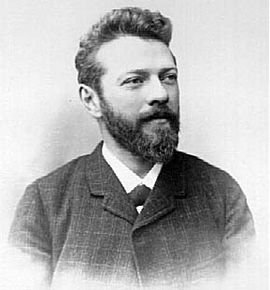MacLeod, Julius (1857-1919)
Botanist and biologist, born on 19 february 1857 in Ostend and died on 3 March 1919 in Ghent. Husband of Fanny Maertens.
Contents
Biography
After completing his secondary education at the athenaeum in Ghent, Julius Mac Leod began his studies at the University of Ghent. In 1878 he obtains the doctorate in natural sciences with the highest distinction. He becomes a preparator in the natural sciences department of the university and, in 1881, assistant in the histological laboratory. From 1881 to 1885 he teaches botany and zoology at the State Normal School in Bruges. Meanwhile, he makes study trips to France, Germany, Switzerland and Italy. As a lecturer in the Faculty of Medicine at the University of Ghent, he teaches the course in Human Physiology from 1885 to 1888. In 1887 he becomes Professor of Botany and director of the Botanical Garden. In the following years, the courses of Botany, Zoology and Ethnographic Geography are added, at the Normal School of Sciences.
In 1897 Macleod, who was politically active in the Flemish movement, was the driving force behind the organisation of the first Vlaamsche Natuur- en Geneeskundige Congressen. He became a corresponding member in 1900 and later, in 1905, a working member of the Royal Flemish Academy of Science. During World War I Julius MacLeod found shelter at the University of Manchester. [1] Shortly after his return from the United Kingdom, Macleod died during a flu epidemic in Ghent on 3 March 1919.
Works
In 1894, MacLeod published Over de bevruchting der bloemen in het Kempisch gedeelte van Vlaanderen (On the fertilization of flowers in the Kempen region of Flanders), the most important work on floral ethology realized by a Belgian.
[2]
He also wrote a survey work on the native flora:Geïllustreerde Flora van België (1892) (Illustrated Flora of Belgium).
[3]
At the University of Ghent, Julius MacLeod became interested in quantitative correlations between plant organs. In 1919 he published The Quantitative Method in Biology, which had been prepared at the University of Manchester.
[4]
Bibliography
- A.J.J. van de Velde, Geschriften van Julius MacLeod, Antwerpen (1942), 173 blz.
- Valcke, L., "MAC LEOD, Julius", In: Nationaal Biografisch Woordenboek, vol. 8, Brussel: Paleis der Academiën, 1979, kol. 456-464.
- Van Oye, Paul, "MAC LEOD, Julius" in Biographie Nationale, vol. 34, Brussels, 1967, 585-590.
Notes
- ↑ Lawalrée, André,De plantkunde, In: Robert Halleux, Geert Vanpaemel, Jan Vandersmissen en Andrée Despy-Meyer (red.), Geschiedenis van de wetenschappen in België 1815-2000, Brussel: Dexia, 2001, vol. 2, p. 253.
- ↑ Lawalrée, André, "De plantkunde", In: Robert Halleux, Geert Vanpaemel, Jan Vandersmissen en Andrée Despy-Meyer (red.), Geschiedenis van de wetenschappen in België 1815-2000, Brussel: Dexia, 2001, vol. 2, p. 250.
- ↑ Lawalrée, André, "De plantkunde", In:Robert Halleux, Geert Vanpaemel, Jan Vandersmissen en Andrée Despy-Meyer (red.), Geschiedenis van de wetenschappen in België 1815-2000, Brussel: Dexia, 2001, vol. 2, p. 250.
- ↑ Lawalrée, André, "De plantkunde", In: Robert Halleux, Geert Vanpaemel, Jan Vandersmissen en Andrée Despy-Meyer (red.), Geschiedenis van de wetenschappen in België 1815-2000, Brussel: Dexia, 2001, vol. 2, p. 253.
